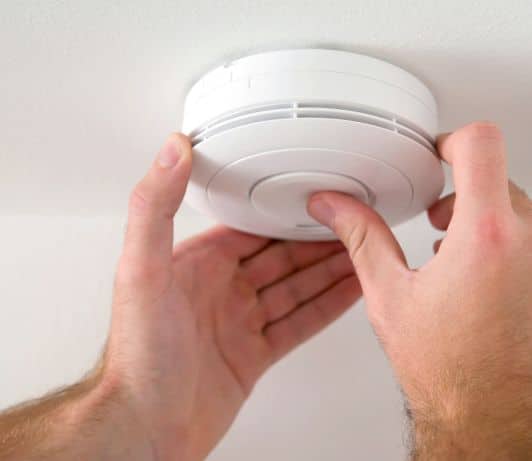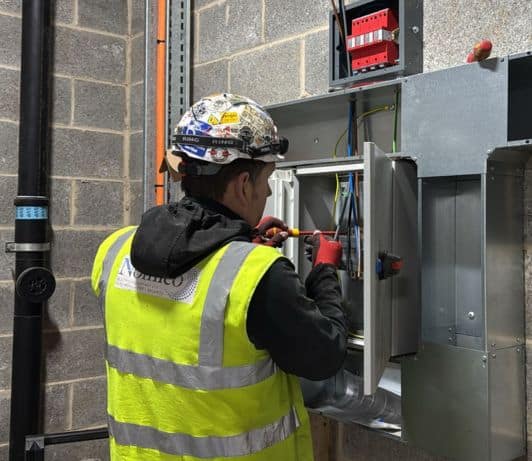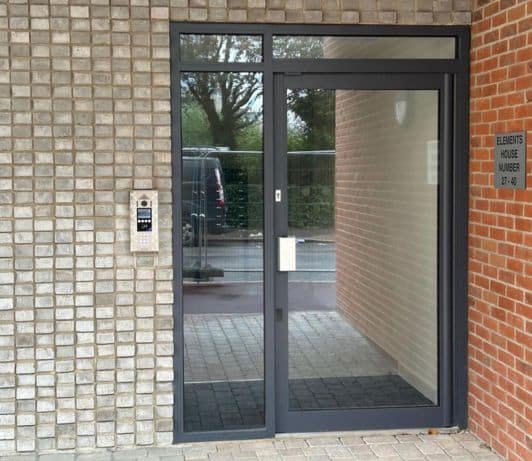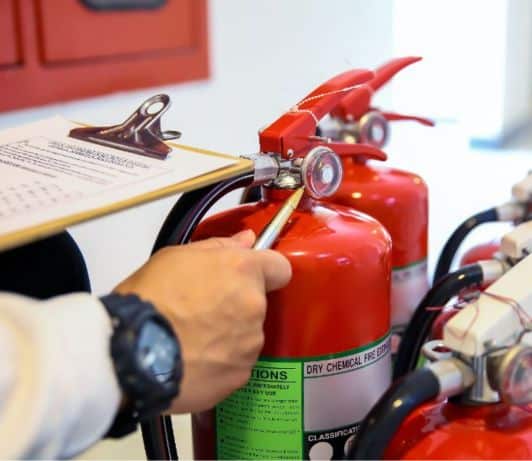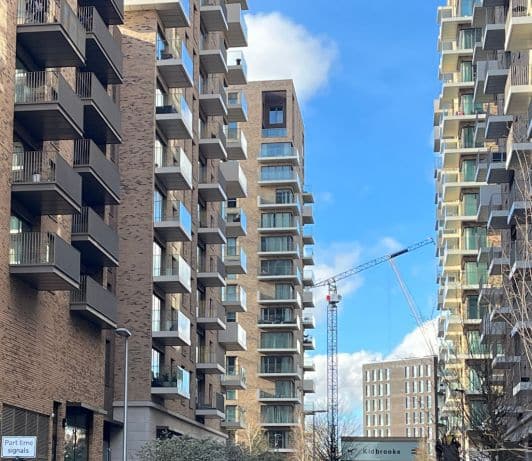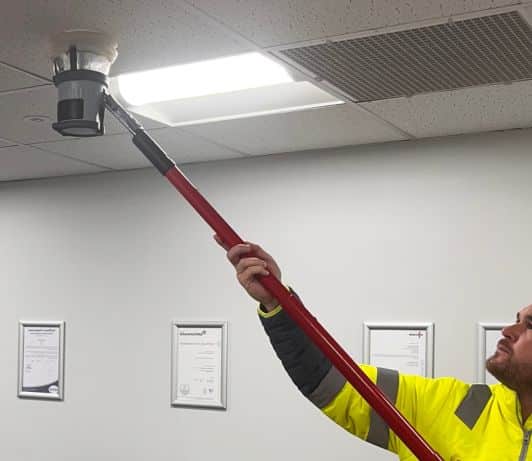Everything You Need To Know About Emergency Lighting Testing
Emergency lighting systems serve as silent guardians in buildings across the UK, ready to illuminate escape routes when darkness falls during power failures. Yet many property owners overlook the critical importance of regular testing and maintenance of the emergency lighting system until faced with compliance issues or, worse, an actual emergency where systems fail to activate.
Understanding emergency lighting testing requirements isn’t just about ticking regulatory boxes; it’s about creating environments where occupants can safely navigate to exits during the most stressful moments, such as a power outage or other emergency situation.
The Regulatory Reform (Fire Safety) Order 2005 places clear obligations on building owners and managers to ensure these systems function correctly when needed most. Regular testing reveals hidden faults, prevents costly penalties, and demonstrates your commitment to occupant safety.
Whether you manage a single commercial property or oversee multiple sites, establishing robust testing procedures protects both lives and your legal standing by ensuring you meet every legal requirement. As a leading safety installer, Nomico Fire & Security understands the regulations our clients face and provides industry-approved testing of all emergency lighting systems.
Using our experience, we are sharing everything you need to know about emergency lighting testing in the UK in this comprehensive guide. We will explore everything from legal requirements to best practices that keep your systems compliant and effective.
What Is Emergency Lighting?
Emergency lighting systems, including emergency lights and each emergency light fitting, automatically activate when the mains power supply fails, providing essential illumination that enables safe evacuation from buildings.
These systems operate independently of normal lighting circuits, drawing power from backup batteries or generators to maintain functionality during power outages, equipment failures, or fire-related electrical shutdowns.
The primary purpose extends beyond simple illumination, as emergency lighting ensures that escape routes remain illuminated and that emergency lights are working correctly during emergencies.
By maintaining adequate light levels along corridors, stairwells, and exit points, these systems guide occupants safely to designated assembly areas outside the building.
Types of Emergency Lighting Systems
To understand what kind of emergency lighting testing is needed across your premises, you first need to identify your emergency lighting. There are several main types of these electrical installations, including:
Escape Route Lighting
This emergency lighting forms the backbone of emergency illumination, marking primary and alternative exit paths throughout buildings.
Each light fitting and emergency fitting along these routes must be regularly inspected and tested to ensure proper operation, with maintenance procedures following standards like BS5266-1.
This lighting maintains minimum illumination levels along corridors, stairways, and exit doors, ensuring occupants can navigate safely even when familiar surroundings become disorienting during emergencies.
Open Area (Anti-Panic) Lighting
This kind of emergency lighting prevents dangerous crowd behaviour in large spaces such as shopping centres, conference halls, and open-plan offices.
Every light fitting and emergency fitting in these areas should be checked for damage, correct wiring, and functionality during routine system tests, helping to prevent panic-induced rushing or trampling and allowing orderly movement toward marked escape routes.
For more advice regarding safety in the workplace, check out this blog.
High-Risk Task Area Lighting
This lighting supports safe shutdown procedures in locations where sudden darkness could create additional hazards. Manufacturing facilities, laboratories, and kitchens require this specialised lighting, with each emergency fitting and light fitting tested to enable safe cessation of dangerous processes before evacuation begins.
Modern emergency lighting systems integrate seamlessly with building management systems, providing remote monitoring capabilities and self-testing emergency features that automate regular testing without human intervention.
These self-testing emergency fittings conduct scheduled tests and report their status, streamlining compliance management while ensuring reliable operation when needed most.
Legal Requirements for Emergency Lighting Testing in the UK
The Regulatory Reform (Fire Safety) Order 2005, together with relevant building regulations, establishes the legal framework and legal requirements regarding emergency lighting requirements across England and Wales.
This legislation designates a responsible person, typically the building owner, landlord, or facilities manager, who must ensure emergency lighting systems across the premises meet prescribed standards and undergo regular testing.
British Standard BS 5266-1 provides detailed technical specifications for emergency lighting testing procedures, establishing minimum requirements that ensure systems in business, commercial, public, and other legally required premises operate correctly.
Compliance with these emergency lighting testing standards in accordance with the law isn’t optional, as failure to meet testing obligations can result in prohibition notices, substantial fines, or even criminal prosecution following serious incidents.
Monthly Emergency Lighting Testing Requirements
Some emergency lighting testing should occur every month across your premises:
Short Duration Tests
Short-duration emergency lighting testing involves a brief activation to test emergency lighting systems and verify their functional operation.
Carrying out these functional tests typically involves switching or using a switch to simulate a power failure, ensuring each luminaire illuminates correctly in emergency mode.
The test usually lasts between 30 seconds and 2 minutes, depending on the emergency lighting system type.
Testing personnel must record results meticulously, noting any faults, dim illumination, or complete failures. These monthly checks identify deteriorating batteries or failing components before they compromise system reliability during actual emergencies.
Visual Inspections
Visual emergency lighting testing should accompany functional tests, examining luminaires for physical damage, missing covers, or obstructed light output.
Signage indicating emergency lighting locations should remain clearly visible and properly positioned according to BS 5266-1 requirements.
Annual Full-Duration Testing
As well as monthly emergency lighting testing, premises must undergo more complex, professional testing every year, including:
Complete Discharge Tests
These are a key part of the annual test process and simulate extended power failures.
This emergency lighting testing is done by running emergency lighting systems until batteries reach their design discharge time, which is typically three hours for most commercial installations. This is done to each luminaire, testing them for their rated duration in accordance with standards like BS 5266.
The discharge test is carried out by a competent person or technician who is responsible for testing emergency lighting systems and verifying that they function correctly for the entire period. We can provide these emergency light testing and maintenance processes to ensure your premises remain safe and compliant.
This comprehensive emergency lighting testing reveals battery capacity degradation and identifies systems requiring immediate attention.
Annual testing provides the definitive assessment of system capability, demonstrating whether emergency lighting can sustain adequate illumination levels throughout realistic emergency scenarios.
Properties with complex systems or multiple buildings benefit significantly from professional testing services that carry out thorough evaluations and ensure accurate documentation. All testing emergency procedures should be carried out in line with regulatory requirements.
Documentation and Record-Keeping
Emergency lighting testing documentation obligations extend beyond simple test completion. A log book must record test dates, results, identified faults, and remedial actions taken.
These records serve as evidence of compliance during fire authority inspections and insurance assessments.
Nomico Fire & Security specialises in maintaining comprehensive testing documentation that satisfies regulatory requirements while providing clear insights into system performance trends and maintenance needs.
Why Regular Emergency Lighting Testing Matters
Emergency lighting systems experience gradual degradation over time, with battery capacity declining and components deteriorating due to environmental factors and normal ageing processes.
As a best practice, these systems must be regularly tested to ensure ongoing compliance and functionality.
Regular testing, guided by a thorough risk assessment, identifies these issues before they compromise system effectiveness during actual emergencies, preventing potentially catastrophic failures when illumination becomes essential for safe evacuation.
1) Ensuring Reliable Operation During Emergencies
Battery performance represents the most common failure point in emergency lighting systems and other emergency equipment.
Without regular discharge testing, batteries may appear functional during brief checks while lacking sufficient capacity for extended emergency situations.
Monthly and annual testing reveals capacity loss, enabling proactive battery replacement before complete failure occurs.
Component failures often develop gradually, with declining light output or intermittent operation preceding complete breakdown. Systematic testing of emergency equipment catches these deteriorating conditions, allowing scheduled maintenance that prevents sudden failures during critical moments.
2) Regulatory Compliance Of Premises
Regular fire alarm service and emergency lighting inspections are essential to demonstrate compliance. Properties with inadequate emergency lighting testing face potential closure until systems meet required standards.
A comprehensive understanding of relevant regulations is necessary to ensure all legal obligations are met.
3) Avoiding Insurance Implications
Emergency lighting testing is also essential for your premises or business insurance. Your insurance implications for not testing emergency lighting can extend beyond immediate penalty avoidance. Insurance policies typically require demonstrated compliance with fire safety regulations, including emergency lighting standards.
Inadequate testing documentation may void coverage or increase premiums significantly, creating substantial financial exposure.
Properties involved in incidents where emergency lighting failures contribute to injuries or fatalities face severe legal consequences, including corporate manslaughter charges against responsible persons who failed to maintain adequate safety systems.
4) Supporting Workplace Safety Culture
Regular emergency lighting testing demonstrates a visible commitment to occupant safety across your premises and reinforces a positive safety culture.
In premises where safety culture is critical, such as hospitals, employees and visitors gain confidence knowing that management prioritises their protection through comprehensive fire safety measures.
Professional emergency lighting testing services provided by Nomico Fire & Security enhance this positive impression by ensuring systems receive expert evaluation using proper procedures and equipment. Choosing our professional engineers demonstrates a serious commitment to safety excellence.
Best Practices for Emergency Lighting Testing & Maintenance
Successful emergency lighting maintenance requires systematic approaches which can integrate seamlessly with the broader facility management processes within your businesses or on site.
Establishing clear procedures for testing emergency lighting, such as manual testing, self-testing, and self-test methods, ensures consistent testing quality while minimising disruption to normal building operations.
Other good practices for emergency lighting testing include:
Scheduling and Planning
Monthly Testing Schedules should distribute testing activities across different building areas to avoid overwhelming maintenance teams while ensuring comprehensive coverage.
Testing schedules may vary depending on building type, occupancy, or regulatory requirements. Large facilities benefit from rotating schedules that test different zones each week, completing full building coverage within monthly timeframes.
Coordinating testing with building occupancy patterns minimises disruption while ensuring thorough evaluation. Evening or weekend testing often proves most practical for commercial properties, though emergency lighting systems should function normally without disturbing routine activities.
Annual Testing Coordination requires more extensive planning due to extended test durations and potential temporary lighting restrictions.
Professional testing services excel at coordinating these complex procedures, managing multiple buildings efficiently while maintaining detailed compliance documentation.
Documentation Excellence
Test Logs must capture essential information, including test dates, personnel involved, specific tests performed, results achieved, and any remedial actions required. Digital documentation systems streamline record-keeping while ensuring information remains accessible during inspections or audits.
Photographic evidence of system conditions before and after maintenance enhances documentation quality, providing visual confirmation of proper testing procedures and remedial work completion.
Modern testing equipment often includes built-in documentation capabilities that automatically generate professional reports.
Proactive Maintenance Strategies
Battery management extends beyond simple replacement schedules, incorporating performance monitoring that optimises battery life while ensuring reliable operation. Environmental factors such as temperature fluctuations, humidity levels, and charging patterns significantly influence battery longevity.
Professional maintenance contracts typically include battery performance analysis that identifies declining capacity trends, enabling planned replacements and ensuring that any faulty or damaged batteries are promptly repaired to minimise emergency failures while controlling maintenance costs effectively.
Another key part of emergency lighting testing and maintenance is regular component inspections. These inspections cover the luminaire condition, mounting security, lens clarity, and signage visibility. Regular cleaning maintains optimal light output while visual inspections identify developing problems before they compromise system performance.
Nomico Fire & Security provides comprehensive maintenance contracts tailored to specific property requirements, combining routine testing with preventive maintenance that keeps emergency lighting systems operating at peak efficiency while ensuring full regulatory compliance.
Common Issues Found During Testing
Professional emergency lighting testing consistently reveals similar problems across different building types and ages, such as faulty lights or emergency lights that fail to operate during tests.
Understanding these common issues enables property managers to implement preventive measures that reduce maintenance costs while improving emergency lighting system reliability.
1) Battery-Related Problems
Capacity degradation represents the most frequent issue encountered during annual full-duration testing. Batteries that appear functional during brief monthly tests may lack sufficient capacity for extended emergency operation, creating dangerous situations where lighting fails during actual emergencies.
Environmental factors accelerate battery deterioration, particularly in areas experiencing temperature extremes, high humidity, or poor ventilation. Basement installations and exterior-mounted units often require more frequent battery replacement due to harsh operating conditions.
Charging system failures prevent proper battery maintenance, leading to gradual capacity loss that becomes apparent only during comprehensive discharge testing. Faulty charging circuits or damaged connections may cause batteries to appear functional while actually operating at significantly reduced capacity.
2) Illumination and Placement Issues
Inadequate Light Levels occur when luminaires fail to meet minimum illumination standards specified in BS 5266-1. Age-related LED degradation, dirty lenses, or incorrect initial installation may reduce light output below required levels, compromising safe navigation during emergencies.
Professional testing includes light meter measurements that verify compliance with illumination standards, identifying areas requiring additional luminaires or upgraded equipment to meet safety requirements effectively.
This also ensures that safety signs are properly illuminated and visible, supporting regulatory compliance and emergency preparedness.
Poor positioning creates shadows or gaps in emergency lighting coverage, leaving critical areas inadequately illuminated during evacuation procedures. Changes in building layout, new furniture placement, or architectural modifications may compromise originally adequate lighting arrangements.
3) Physical Damage and Environmental Issues
Damaged fittings result from normal wear, accidental impacts, or environmental exposure. Cracked lenses, loose mounting hardware, corroded connections, or a damaged emergency fitting reduce system effectiveness while creating potential safety hazards from falling components.
Regular inspection identifies developing damage before complete failure occurs, enabling cost-effective repairs that maintain system integrity while avoiding emergency replacement costs during actual incidents.
Missing or damaged signage prevents occupants from locating emergency lighting during high-stress situations. Faded exit signs, missing directional indicators, or obscured emergency lighting symbols significantly reduce system effectiveness regardless of proper luminaire operation.
Comprehensive testing addresses signage conditions alongside luminaire functionality, ensuring complete emergency lighting systems provide effective guidance throughout buildings during evacuation procedures.
Conclusion
Emergency lighting testing represents a fundamental responsibility that protects lives while satisfying legal obligations.
The complexity of modern emergency lighting systems, combined with evolving regulatory requirements, makes professional testing services increasingly valuable for property owners seeking reliable compliance management.
Proper testing ensures that the system carries the normal mains supply, backup power, and control signals as intended, which is essential for effective operation and compliance.
Regular testing prevents system failures during actual emergencies while demonstrating commitment to occupant safety that strengthens workplace culture and public confidence.
Nomico Fire & Security’s comprehensive approach to emergency lighting testing ensures your property meets all regulatory requirements while operating at optimal efficiency. Our qualified engineers, advanced equipment, and integrated service delivery transform fire safety compliance from a complex challenge into a streamlined process that provides lasting peace of mind.
Contact Us Today
Don’t wait for compliance issues or system failures to reveal inadequate emergency lighting maintenance. Contact us today to schedule professional testing that protects your property, your occupants, and your business interests through expert fire safety system management.
Frequently Asked Questions
How often should emergency lighting be tested in the UK?
Monthly functional tests lasting 30 seconds to 2 minutes must verify basic system operation, while annual full-duration tests simulate a complete power failure or power cut for up to 3 hours.
BS 5266-1 standards specify these minimum requirements, though high-risk properties may require more frequent testing schedules.
Who is responsible for ensuring emergency lighting compliance?
The “responsible person” designated under the Regulatory Reform (Fire Safety) Order 2005 holds legal accountability for emergency lighting compliance. This typically includes building owners, landlords, facilities managers, or designated safety officers who must ensure systems receive proper testing and maintenance.
What happens if emergency lighting fails compliance testing?
Failed systems require immediate remedial action to restore proper operation before the next scheduled test period.
Nomico Fire & Security coordinates necessary repairs, component replacements, and system upgrades while maintaining detailed documentation that demonstrates compliance restoration for regulatory authorities.
How much does professional emergency lighting testing cost?
Testing costs vary based on building size, system complexity, and service frequency requirements. Nomico provides detailed quotes that outline all testing procedures, documentation, and included services, often delivering cost savings through efficient scheduling and preventive maintenance that reduces emergency repair expenses.

